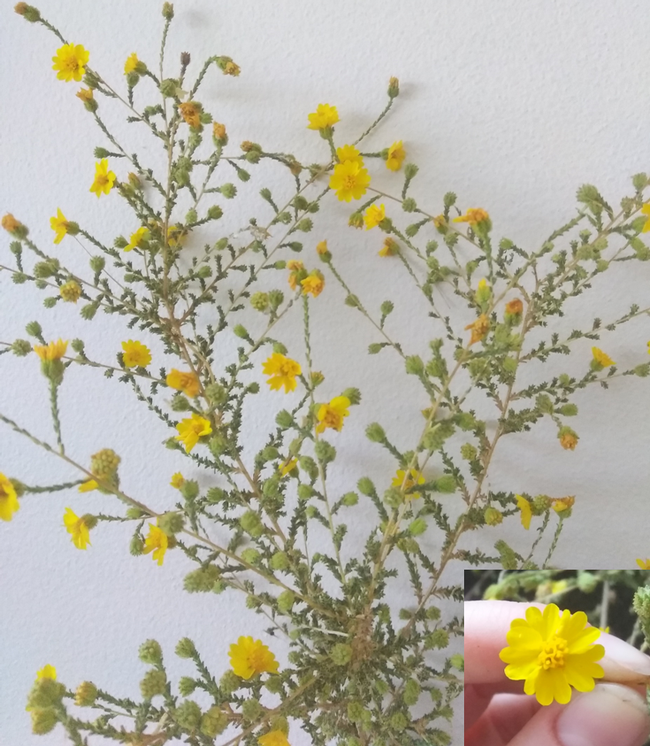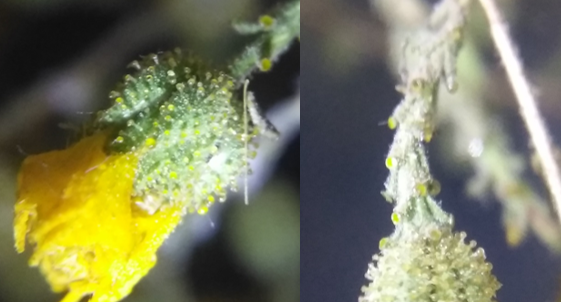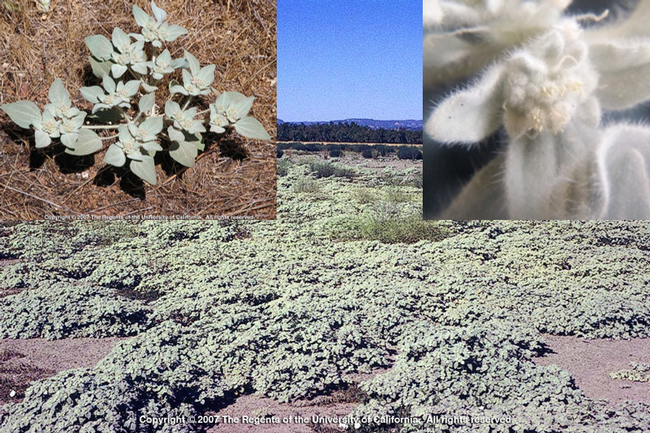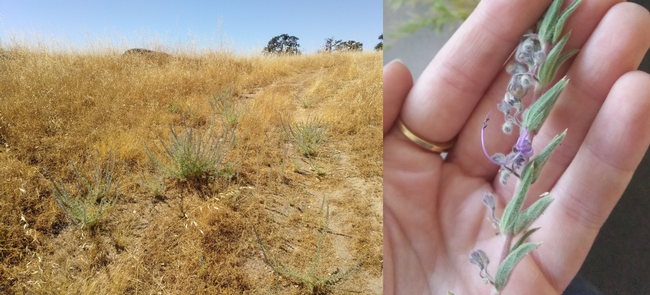Tarweeds, vinegarweed and turkey mullein are native forbs that stand out in Fresno and Madera County rangelands during the summer. Unfortunately, they aren't the most welcome. Horse owners despise tarweed because its sticky resin turns even brightly colored horses a grim muddy color; many rangeland owners dislike vinegarweed for its pungent smell; and turkey mullein, though common, is often disregarded until it looks like it has taken over dozens of acres overnight.
Although their native status may appease some landowners – they can provide food and habitat for some bird and pollinator species – most ranchers couldn't care less. Why, you may ask? These plants are poor forage for livestock, and most animals tend to avoid these species.
Table 1. Reasons why three native forb species are not useful forage for grazing livestock.
|
Species |
Key reason |
Secondary reason(s) |
Toxic to livestock? |
|
Tarweeds (Hemizonia and Holocarpha spp.) |
Sticky resin (stains animal hair/fur and collects dirt and dust) |
Little desirable foliage available |
No; they occasionally graze it when it is young and non-resinous (1) |
|
Turkey Mullein (or Doveweed; Croton setigerus) |
Dense, almost spiny hairs – irritant and potential gut blockage |
Contains mono- and diterpenes in all plant parts – vesicant (causes blisters), toxic to some animals (2, 3, 4) |
Maybe |
|
Vinegarweed (Trichostema lanceolatum) |
Pungent aromatic compounds |
Learned response - essential oils may interfere with ruminant digestion (5) |
No |
All of these species occupy rangelands throughout California and tend to be more abundant where grasses are less abundant, such as low-traffic ranch roads or other disturbed soil. Turkey mullein often thrives on roadsides here where grass is sparse. Aside from releasing volatile aromatic compounds that tickle the nose, these plants can be a nuisance if they dominate grazing lands and limit access to good forages. Tarweeds can outcompete grasses near them depending on grazing management and weather conditions from year to year, and in summer can grow to the point where livestock cannot easily access the dried forages below them.
Above: Tarweed (specifically, Holocarpha virgata) collected from the San Joaquin Experimental Range in mid-September was abundantly flowering. In early October, another ranch visit in Fresno County showed that tarweed was still flowering even at the end of summer. Note the plant's stemmy structure and tiny leaves.
Inset: Tarweed is a helpful source of summer pollinator food. Some tarweed species have more or fewer ray flowers than this example, and a variety of shapes; leaf size and shape also vary among species.
Below: Closeup of sepals (left) and leaves (right) on the same plant, exuding sticky resin. All leaves and sepals on this species produce this resin, helping the plant stick to – or annoy – anything that comes its way. If you look closely at the sepal image, you will notice a small leaf and stem from another plant have gotten stuck on the resin.
Tarweeds, turkey mullein and vinegarweed tend to flower and remain green through at least part of the summer when most forages have senesced. I collected specimens of all three of these forbs from the San Joaquin Experimental Range (Madera County) in mid-September and all were actively flowering. In contrast, all the grasses had dried and dropped seed several months prior to my visit. These forbs' phenology makes them much easier to detect as green or gray-green spots in an otherwise golden annual grassland. In addition, desired forage species are unlikely to be impacted if a manager wants to attempt summer control of these species with herbicides – most of our forages are annuals with no vulnerable live tissue after the rainy season ends.
Above: Turkey mullein plants can be small (top left, photo © 2008 Joe DiTomaso) or they can grow into large mounds with enough space and resources (large background, photo © 2008 Joe DiTomaso). All parts of the plant are densely hairy (close-up, top right).
These species are well adapted to the areas they inhabit, and highly persistent. While tarweeds, turkey mullein and vinegarweed are not typically harmful to livestock or people, they may be nuisances. Tarweed's resin makes for sticky walks through an infested pasture, and some folks find tarweed and vinegarweed to have strong, offensive odors. While reading about turkey mullein I discovered that people can develop blisters from handling it even while wearing leather gloves (2). For an innocuous-seeming plant, it apparently has quite a sting. This might cause irritation for summer grazing livestock if a field is dominated by turkey mullein to the point where livestock would put their faces among dense plants to access forage. With that said, I have yet to see a grazing area with so much turkey mullein that forage is hard to access.
Above: (Left) Vinegarweed occupying open, disturbed parts of the San Joaquin Experimental Range. This photo was taken in mid-September; note how all other herbaceous vegetation is dry, while vinegarweed is green and flowering. (Right) Close-up of vinegarweed stem with delicate purple flower. These flowers provide bees and other insects with summer nectar. Stems, leaves and sepals are covered in fine hairs.
Although widespread, these species are not typically problematic for ranchers in my area, and luckily for me, I enjoy the bouquet of all their aromas – from a safe distance.
For management options (good luck!) and further reading:
Tarweeds
https://wric.ucdavis.edu/information/natural%20areas/wr_H/Hemizonia_fitchii-parryi-pungens.pdf
https://wric.ucdavis.edu/information/natural%20areas/wr_H/Holocarpha.pdf
Winans, S. S. and C. M. McKell. 1963. Tarweed…a nuisance plant on California ranges. California Agriculture 17(4):11-13. Available at http://calag.ucanr.edu/archive/?article=ca.v017n04p11.
Turkey Mullein
http://ipm.ucanr.edu/PMG/WEEDS/turkey_mullein.html
Vinegarweed
https://wric.ucdavis.edu/information/natural%20areas/wr_T/Trichostema.pdf
Heisey, R. M. and C. C. Delwiche. 1985. Allelopathic effects of Trichostema lanceolatum. Journal of Ecology 73:729-742. Available from https://www.jstor.org/stable/pdf/2260142.pdf.
References:
- Perrier, G. K., W. A. Williams, and J. W. Menke. 1982. Tarweed, an unloved annual-typed range plant. Rangelands 4:149-150. Available at https://journals.uair.arizona.edu/index.php/rangelands/article/view/11736/11009.
- Naito, S. and C. R. Noller. 1960. Note on the chemical components of extracts of Eremocarpus setigerus. Journal of the American Pharmaceutical Association 49:557-558. Available from https://onlinelibrary.wiley.com/doi/abs/10.1002/jps.3030490818.
- Jolad, S. D., J. J. Hoffmann, K. H. Schram, J. R. Cole, M. S. Tempesta, and R. B. Bates. 1982. Constituents of Eremocarpus setigerus. Journal of Organic Chemistry 47: 1356-1358. Available from https://pubs.acs.org/doi/pdf/10.1021/jo00346a042.
- Bajaj, R., C. J. Chang, J. L. Mclaughlin, R. G. Powell, and C. R. Smith, Jr. 1986. Tiliroside from the seeds of Eremocarpus setigerus. Journal of Natural Products 49: 1174-1175. Available from https://pubs.acs.org/doi/pdf/10.1021/np50048a060.
- Schultz, T. H., D. R. Black, T. R. Mon, and G. E. Connolly. 1976. Vinegar weed volatile constituents. Journal of Agricultural and Food Chemistry 24:862-865. Available from https://pubs.acs.org/doi/pdf/10.1021/jf60206a023.



